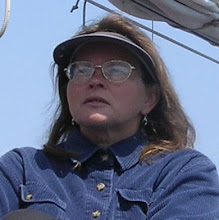There is a unique rock formation at the eastern tip of the Swallowtail peninsula beneath where the fog bell and small building (now attached to the lighthouse) were located. From a certain angle these rocks look like a woman with a baby on her back or children climbing the rocks with a dog waiting beneath them. Even if the light house wasn't visible in thick fog, if these rocks were glimpsed, the mariner would know where they were. Of course, at Swallowtail, the fog bell and later fog horn would be another clue, but most of these formations are not located at a lighthouse.
I first learned of this when I was sailing around Swallowtail with one of the older fishermen. He pointed out the rock formation and had described it as a woman with a baby, but it was later described as a girl and a boy, a boy with a backpack, etc. The dog, however, is always the lower rock.

Next time you are travelling on the ferry, look for these rocks. They can only be seen from certain angles.












